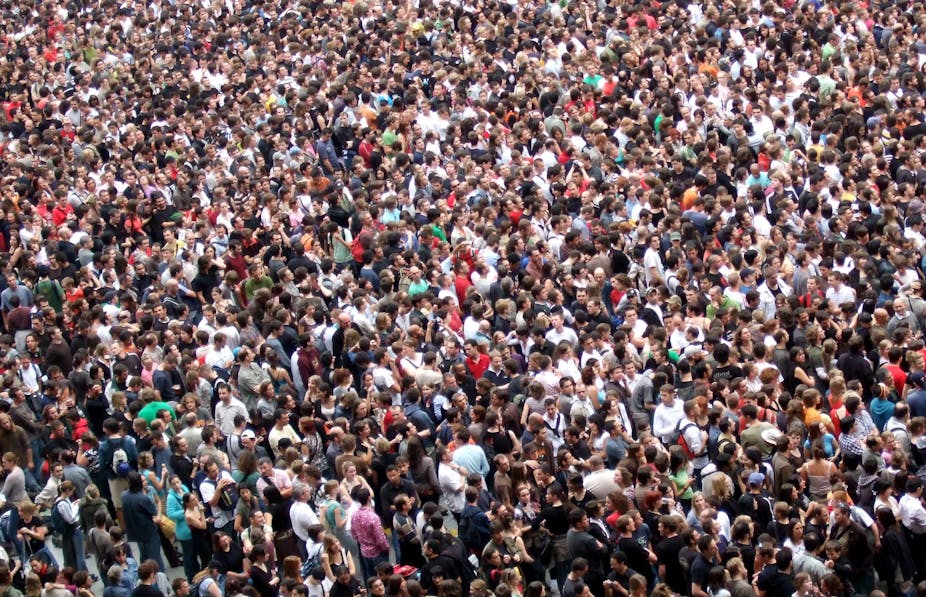People who love animals and open spaces often have little use for other people. Naturalist David Attenborough recently described humans as “a plague on earth”. David Foreman of Earth First has set a goal of reducing the world’s human population to 100 million.
Does the earth have too many people for its own good? Can another three or four billion be added (the current United Nations projection for 2100) without fatally harming the planet?
The issue is not one of how many people the planet can support, but how wastefully and aggressively those people act.
Ten thousand years ago, with less than five million people on the Earth, large animals were already being hunted to extinction by aggressive humans. It was the domestication of plants and animals that filled the world with both humans and large herbivores. Today, with seven billion people, these herds of pigs and cattle satisfy our ever-growing demand for meat.
Untouched wilderness seems scarcer (although national parks in the US remain much as they were a century ago, once you leave the concession stands and roadside attractions). But true wilderness, untouched by humans, on Amazon rainforest and American plains ceased to exist thousands of years ago when human populations were a tiny fraction of what they are today. Native Americans burned, dug, and reshaped the forests and plains to suit their needslong before Columbus brought guns and horses to the New World.
Won’t too many people drain food supplies, produce poverty and damage the climate? Again, it is not the number of people but how they act that matters. Food supplies are fine – it is food distribution that is the problem. Malnutrition remains a problem, even among the obese, because while they get plenty of calories from sugary and starchy processed foods, they lack access to fresh and varied diets rich in minerals and vitamins. The latter is a matter of income distribution and marketing. Humans today eat too much meat and too much sugar and too much alcohol; healthier diets would be better for the planet as well as for people.
The last 30 years have seen both the fastest global population growth in history and the largest reductions in poverty in history. As populations in Asia have moved into cities and raised their incomes, while farming has gained in efficiency, ever-larger populations have found better jobs and been better housed and fed than ever. As long as people become more productive, more of them means a higher standard of living for all, not lower.
Fears of climate change now reverberate widely. But again, the problem is not too many people. Far more damage was done to Earth’s climate by clorofluorocarbons used to power air conditioners for a tiny number of people in rich countries in the 1960s and 1970s, before they were banned, than by all the billions of people who have ever lived in poorer nations. Learning how to heat and cool our homes, and power our cars and factories, in more efficient and less climate-influencing ways is a priority.
People who fear overpopulation commit the fallacy of simply multiplying faults – they take the most harmful and wasteful actions of any set of people today and multiply it by the growing number of people in the world. The auto emissions and air conditioning habits of Los Angeles in the 1970s, for example, were unsustainable. But as the number of people grew, their habits and behaviour changed in order to improve their environment. They did not stop driving or air-conditioning. Yet they succeeded in finding cleaner and more efficient ways to carry out those activities. The result is that cities in Europe and North America, though many times larger than they were in 1900, are cleaner, healthier and more pleasant places than they were when their populations were far smaller.
There are some places in the world today where populations are still growing too fast. Particularly in sub-Saharan Africa, women in many countries still have four to five children, a rate of growth that can undermine further progress.
Yet what we have seen in many poor countries is that if families shift to having less than four children per family, a virtuous cycle kicks in: with fewer children, families can spend more to educate them. Educated young people themselves tend to have fewer children and invest more in them. This cycle thus kicks progress forward very quickly and leads to falling birth rates.
Doing away with billions of people is no substitute for doing away with the vices in people’s behaviour. Instead we need to pursue cleaner, healthier, and more ecologically sound lifestyles and ways of satisfying our needs. For that we need more, not less, creative and passionate people to guide us to a better future. The planet can handle it, if we improve how we handle ourselves.

